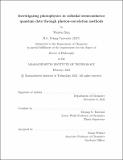| dc.description.abstract | Colloidal semiconductor quantum dots (QDs) exhibit interesting photophysical properties due to their quantum-confined nature. Due to their bright and stable photoluminescence, they have been widely used in a variety of applications, including lasing, light emitting diodes (LEDs), solar cells, biological imaging, and most recently quantum information science. Numerous efforts have been made to optimize these QDs to improve their performance, which all require the establishment of an efficient feedback loop between optical properties and synthesis. Spectroscopic studies on their PL properties would inform us about the nature of QD emission and point new directions for future design and optimization of QDs.
In this thesis, I will use photon-correlation-based spectroscopy, a powerful toolkit with both high temporal and spectral resolutions, to investigate the exciton photophysics inside these QDs to build a complete understanding of the exciton dynamics in cesium lead halide and CdSe/CdS quantum dots. In the first two chapters, I will build a foundation on the understanding of semiconductor quantum dots, quantum emitters, and single particle spectroscopic techniques. In the next two chapters, I will use photon-correlation Fourier spectroscopy (PCFS) to investigate single particle optical coherence properties, to demonstrate cesium lead halide perovskite quantum dots (PQDs) as the next-generation quantum emitter materials for quantum information science, and investigate their dephasing mechanisms at cryogenic temperatures. In the next chapter, I will switch gears to CdSe/CdS quantum dots to develop the first-time all-optical deterministic blinking control method and explain the mechanisms behind it. Finally, I will present a few interesting and unexplored ideas in understanding the nature of fine structure states in PQDs and the integration of nanophotonic cavities to achieve true transform-limited single quantum emitters and large-scale generation. | |
